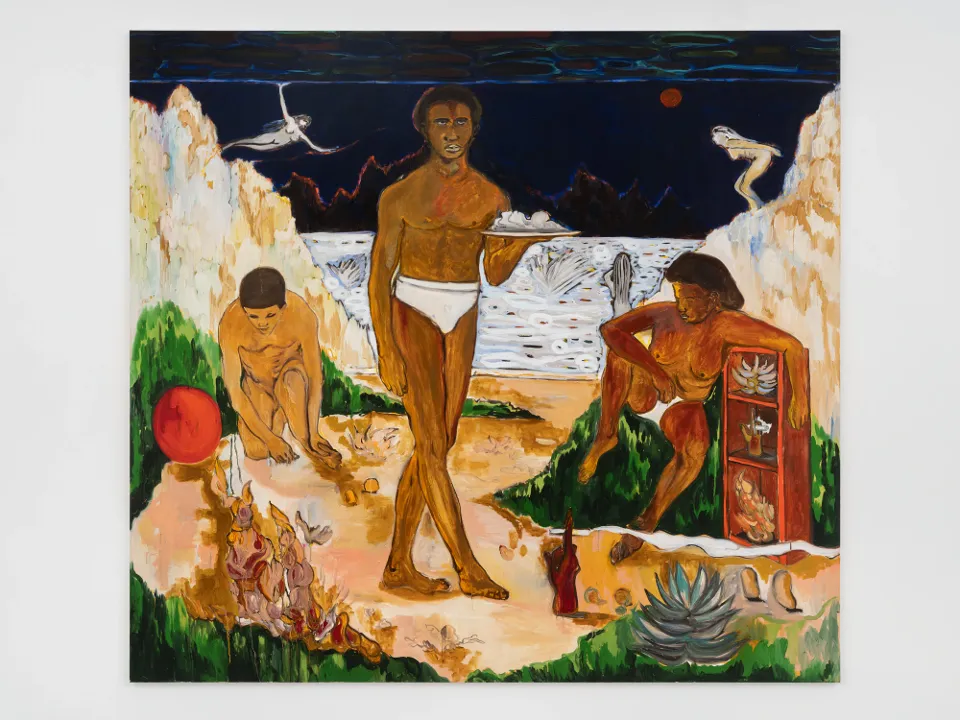Marking the artist’s second solo show with the gallery since he joined its program in 2022, and his first-ever solo exhibition in Asia, this presentation will feature paintings and drawings that examine memory and sensuality through Appah’s virtuosic compositional arrangements and his surrealist visual language. The exhibition will be accompanied by a digital catalogue produced by Pace Publishing.
Known for his rich, jewel-toned figurations, Appah paints utopian landscapes that serve as intuitive, outward translations of the inner self. The oneiric, often coastal realms of Appah’s paintings are inhabited by nude and semi-nude figures inspired by the artist’s imaginative readings of archival imagery. Using layered impasto, Appah constructs worlds that, though visually flattened, take on a seemingly infinite breadth that is at times unsettling and, alternatively, inviting and seductive.
In the new paintings, Appah expands his expressions of memory and cultural identity through his evolving technique and renewed commitment to his distinctive surrealist vocabulary. Within his expansive canvases, life-size athletic figures find anchorage in meticulously crafted landscapes made up of careful interplays of line, color, light, and shade. Appah’s substantial and layered application of paint dissolves any suggestion of rigidity in his compositions—an effect that he accentuates by revealing areas of undercoat. Left unworked, these abstract sections of lightly washed and dripped paint give rise to almost identifiable forms from within the canvases. Further subverting narrative expectations is the apparent indifference of the figures to one another and the viewer—as if in a memory or dream, they embrace, swim, play music, and recline in states of undisturbed reverie.
Drawing inspiration for his paintings from a vast visual archive that includes newspaper clippings, family photographs, and Ghanaian films and documentaries—especially those made during a major period of cultural production after the country gained independence in 1957—Appah imbues his works with a uniquely cinematic, scenographic quality. In an act of creative reinvention, the artist transforms moving images from film for his two-dimensional works, suspending time and dislocating any sense of place in the process. His interest in monochromatic imagery is also central to his approach—for Appah, black-and-white film is not limiting but rather a perfect vehicle for investigating the expressive potential of light, shade, and hue. Guided by images he has encountered in classic Ghanaian cinema, he overlays vibrant colors onto these scenes, making them entirely new and uniquely his own.
Throughout Appah’s oeuvre, surrealist motifs abound. Disembodied heads, smoking hands, and suited torsos float alongside similarly uprooted—or unrooted—vegetation, merging seamlessly into the atmosphere of individual works. Also featured in Seoul will be a selection of charcoal drawings showcasing these motifs, marking the artist's debut exhibition of works on paper with Pace. Initially conceived as preparatory sketches, Appah now regards them as standalone works. Taking on a dreamlike sensibility detached from any identifiable narrative, these monochromatic drawings, alongside The Sensitivity of Everyday Things series—an ongoing body of paintings that explore the rituals of daily life—offer visitors insight into his imaginative process.
Known for his rich, jewel-toned figurations, Appah paints utopian landscapes that serve as intuitive, outward translations of the inner self. The oneiric, often coastal realms of Appah’s paintings are inhabited by nude and semi-nude figures inspired by the artist’s imaginative readings of archival imagery. Using layered impasto, Appah constructs worlds that, though visually flattened, take on a seemingly infinite breadth that is at times unsettling and, alternatively, inviting and seductive.
In the new paintings, Appah expands his expressions of memory and cultural identity through his evolving technique and renewed commitment to his distinctive surrealist vocabulary. Within his expansive canvases, life-size athletic figures find anchorage in meticulously crafted landscapes made up of careful interplays of line, color, light, and shade. Appah’s substantial and layered application of paint dissolves any suggestion of rigidity in his compositions—an effect that he accentuates by revealing areas of undercoat. Left unworked, these abstract sections of lightly washed and dripped paint give rise to almost identifiable forms from within the canvases. Further subverting narrative expectations is the apparent indifference of the figures to one another and the viewer—as if in a memory or dream, they embrace, swim, play music, and recline in states of undisturbed reverie.
Drawing inspiration for his paintings from a vast visual archive that includes newspaper clippings, family photographs, and Ghanaian films and documentaries—especially those made during a major period of cultural production after the country gained independence in 1957—Appah imbues his works with a uniquely cinematic, scenographic quality. In an act of creative reinvention, the artist transforms moving images from film for his two-dimensional works, suspending time and dislocating any sense of place in the process. His interest in monochromatic imagery is also central to his approach—for Appah, black-and-white film is not limiting but rather a perfect vehicle for investigating the expressive potential of light, shade, and hue. Guided by images he has encountered in classic Ghanaian cinema, he overlays vibrant colors onto these scenes, making them entirely new and uniquely his own.
Throughout Appah’s oeuvre, surrealist motifs abound. Disembodied heads, smoking hands, and suited torsos float alongside similarly uprooted—or unrooted—vegetation, merging seamlessly into the atmosphere of individual works. Also featured in Seoul will be a selection of charcoal drawings showcasing these motifs, marking the artist's debut exhibition of works on paper with Pace. Initially conceived as preparatory sketches, Appah now regards them as standalone works. Taking on a dreamlike sensibility detached from any identifiable narrative, these monochromatic drawings, alongside The Sensitivity of Everyday Things series—an ongoing body of paintings that explore the rituals of daily life—offer visitors insight into his imaginative process.
| 작가 | Gideon Appah |
| 전시장 | 페이스갤러리 서울 (Pace Gallery Seoul, ペース・ギャラリー・ソウル) |
| 주소 | 04348 서울 용산구 이태원로 267 페이스갤러리 |
| 오시는 길 | 지하철 6호선 한강진역 1번 출구에서 185m |
| 기간 | 2024.03.21(목) - 04.27(토) |
| 관람시간 | 10:00-18:00 |
| 휴일 | 일요일, 월요일 |
| SNS | |
| 웹사이트 |




